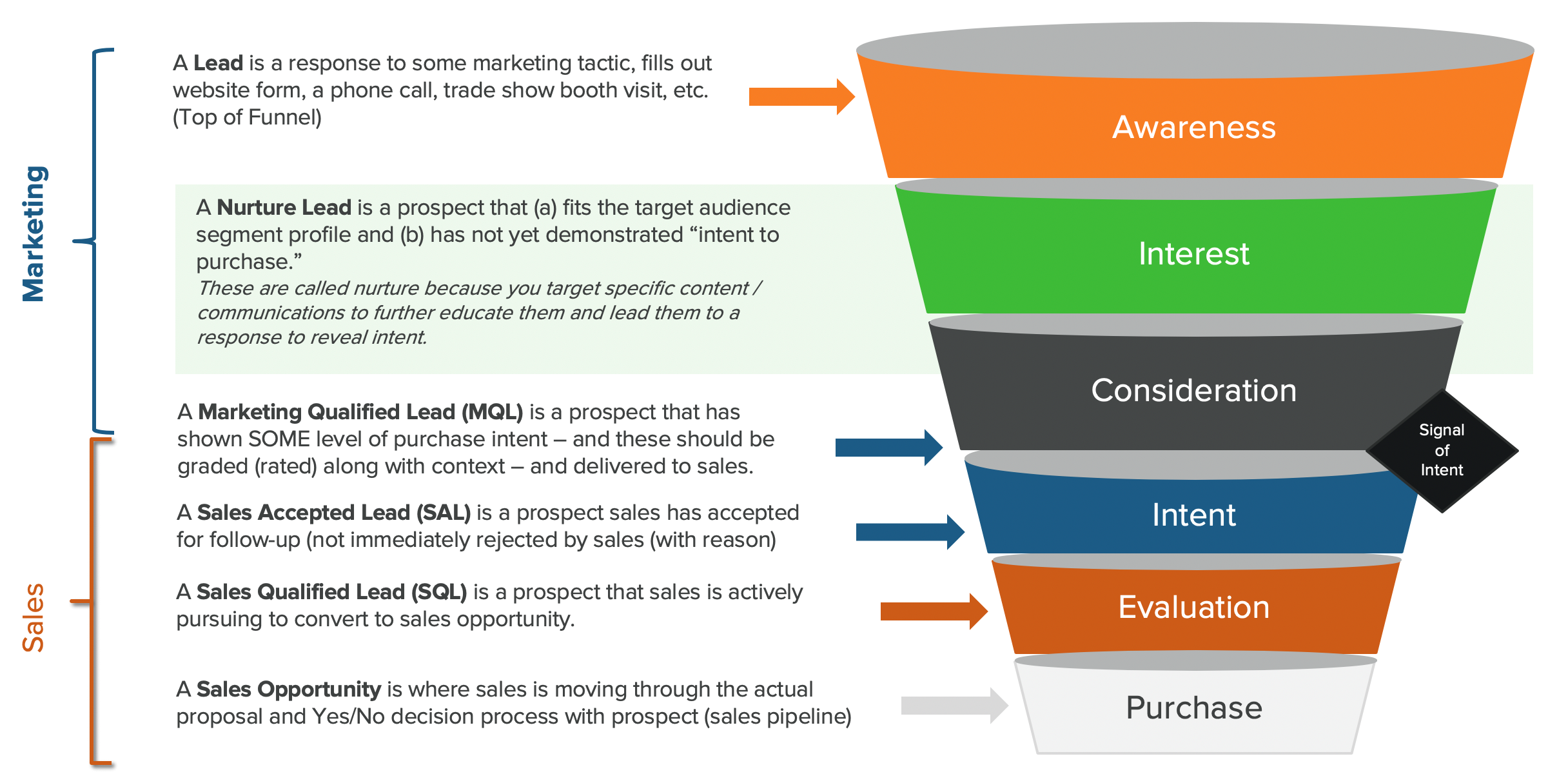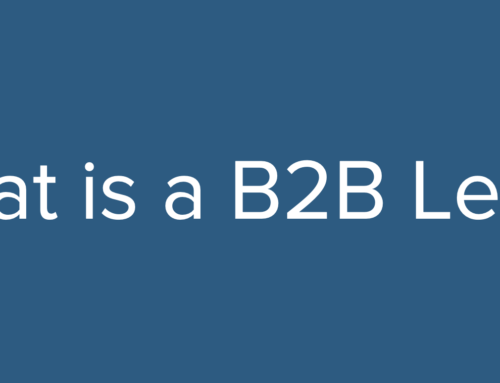We have arrived at the #5 thing I believe every CEO should know about marketing. In case you are new to the series, you can find #1 – #4 (The “Ante”, Not all marketing is the same, B2B buyer journey, and B2B website purpose) in our blog.
![]()
#5 is about alignment – specifically marketing and sales alignment around one specific definition. There are certainly many areas where marketing and sales should learn to effectively understand needs and agree on desired goals and outcomes. However, I believe there is one key definition that subtly and yet so definitively will decide how effective these two groups will be in winning for your company.
Marketing and sales needs to collaboratively agree on the definition of a marketing qualified lead (MQL). Click To TweetWhy is this so important. Consider that “61% of B2B marketers send all leads directly to sales; however, only 27% of those leads will be sales qualified” (source – Marketing Sherpa). Statistically, this means there appears to be quite a disconnect between the leads that some marketers are sending to sales and those that sales will qualify as a legitimate sales lead. This usually happens if either (a) marketing is indeed sending leads that are not useful, failing to send enough lead context, or delivering leads far too late — or (b) sales has a very narrow view of what they expect from marketing (e.g., just wanting “sales ready leads”). The result is always that marketing and sales end up playing the blame game on lead quality and quantity.
While this will never be 100% of course, I firmly believe that working harder to jointly agree on what a true marketing qualified lead (a lead that both marketing and sales want sales to see) will generate far greater attention from sales (more confidence in leads) and more success in terms of how many of those become sales qualified leads.
What is a MQL (marketing qualified lead)?
One key job of your marketing team is to generate potential sales leads from various sources (e.g., paid search, events, webinars, white paper downloads, website contact us forms). However, not all leads are the same. Some leads are worthless like competitors or companies that are not true prospects but just wanted information for some reason etc Some leads are perhaps closer to your target audience profile (company, job title, etc.) but are just not a fit (too small, too large, really not interested). And of course, some leads are the right profile fit and express some form of “intent” in their buyer journey (see Figure 1 that outlines the types of leads one can identify across the buyer journey to the funnel on right) to indicate they may be a lead that sales should see. You will see the MQL leads listed at the point where there is some “signal of intent” (meaning, some response that indicates the buyer is intending to move towards a purchase).
Figure 1 – Buyer Journey – Types of Leads

What is the definition of MQL that requires marketing and sales alignment?
What is essential is that marketing not use the generic definition I have provided above to have a one-way definition of an MQL that they want sales to blindly accept. That will likely lead to greater dissatisfaction with sales in the quality of the MQLs they receive, a loss of confidence in marketing, and a low MQL to SQL (sales qualified lead) conversion rate – in other words – FAIL!
💡 ADDED INSIGHT: As a CEO, do NOT let sales narrowly defined MQLs as “sales ready leads” – in other words, people that we just KNOW are ready to buy. If those are the only leads they want, then you just need people to respond to quote requests or take orders and probably don’t need real sales people who have to “convert” leads into sales. “Sales ready” leads are infrequent in the B2B world and when you do find one, you are late to the party as they are probably just wanting to talk about price and matching their RFP. They have already determined what features/functions they value and why.
So what does marketing and sales alignment look like? For marketing and sales to gain alignment on the definition of a true MQL, those groups will need to collaborate on these three key lead anatomy elements:
MQL Lead Profile – All should agree on what profile (or profiles if you have more than one segment) matches the target prospect that will qualify as a potential buyer and/or key influencer. In other words, you have to agree on “who” sales wants to have a relationship with since sales doesn’t want to waste time on unqualified buyers. Key profile elements to agree on can vary, but will include things like:
- Company type and industry
- Job function or Job title
- Geographic location (if that matters)
- Company size (revenue or employees)
Any possible MQL leads should match this profile. This doesn’t mean the lead is an MQL, but if the profile does not match it certainly means that this is an unqualified prospect and should be discarded (a COLD lead).
MQL Lead Context – Lead context is about the source of the lead and the actual response of the prospect.
- Is this a prospect that asked for a quote?
- Is this a prospect that filled out a “contact us” form?
- Is this a webinar lead? If so, did they attend or just register? If they attended, how long were they on the webinar and did they answer a poll question or ask a question during the Q&A time (and what question)?
- Is this a prospect that downloaded a white paper? Did they also check a box specifically asking to speak to sales? Did they answer a custom question about their project timeline (which might be used to further qualify)?
- Is this a person that just stopped by the trade show booth and got a badge scanned, or did they specifically inquire about a product or watch a demo?
- Is this a prospect that just clicked on an email link?
- Is this a prospect that visited our website 10 times?
You get the point. Some types of “lead context” can be established clearly – things like responses via your contact us form, or if you have a request a quote form specifically, or some specific website activity behavior. However, what most marketing and sales teams fail to do is to have discussions around each specific campaign they execute (when they use various tactics like white papers, webinars) to agree on which lead context should qualify a prospect as a MQL.
Most unique marketing tactics have unique context variables. What is important is that marketing and sales agree on which kinds of sources and responses gathered from these tactics will be used to determine whether a lead is an MQL (and given to sales) or perhaps just saved by marketing for additional nurturing.
💡 ADDED INSIGHT: I see one HUGE failure over and over again with companies that either (a) don’t have any lead management tools or CRM, or (b) those that specifically only use their CRM to proess leads. They define these lead context criteria but they fail to (or don’t have the ability to) pass these context details along to the sales person. When a sales person gets a lead, that lead should have AS MUCH context as possible. For instance, our webinar example above. If they attended a webinar, the lead should have name of the webinar, date of webinar, link to the slides, link to the recording, the number of minutes this prospect attended, and any poll question answer or direct questions that person asked. This rich data turns a cold call into an intelligent warm call. Too may approaches and systems only allow for very few and highly pre-determined, structured types of information to be passed along and the sales person knows too little about the response.
MQL Lead Classification (and Delivery – a given) – First, a comment on the inclusion of “delivery” in this heading. Delivery – IMMEDIATE delivery – should be an expectation. However, this is such a real problem for many. Make sure that marketing is committed to delivering a lead as quickly as possible to sales. For web responses, this would mean within seconds. For leads from webinars it should be within hours of the webinar end. For events, the day after the event ends (or maybe 2 days at most). Leads are perishable. “50% of all sales (wins) go to the company that responds first” (source: insidesales.com) The flip side of that is that sales has to agree to respond immediately as well and that leads us to the true topic of lead classification.
Now on to lead classification. Lead classification is about using a set of grades, levels, or scores that clearly communicate to sales about the urgency and expected quality of each lead they receive. One criteria for this grade or score would be the lead profile discussed above (they have to be a fit – that is either yes or no with “no” meaning this is not a MQL).
The second criteria that will actually determine the grade will be the lead context (discussed above) and you are basically wanting to triage leads through this lens to determine if they are “nurture” only (marketing will just nurture and not send to sales now) or whether they are some other grade (like FYI Only, Warm, Hot) that will communicate the quality and urgency to sales.
Basically, these two criteria provide the quality of the contact and the type of intent identified by the response.
For example, if a lead is a result of someone asking for a quote, that lead should be graded “Hot” (or whatever classification method you use). This will tell sales they are supposed to follow-up immediately. Leads with this classification can be identified in reporting so that sales management and marketing can measure the average time it takes each salesperson to complete that follow-up.
Another example might be a webinar lead. Maybe you and sales agree that anyone attending the webinar that fits the profile is an MQL. But you also agree that those that asked a question during the webinar will be “Hot” (discussed already) and the remaining attendees will be “Warm.” A warm lead would let them know that this type of lead is a prospect that has shown great interest in a strongly related topic that shows intent to learn more. The “warm” grade might signal that sales should treat this as a “how can I help you get more information” type of approach vs. a “you wanted to speak to us” type of lead. Sales might be told to (and measured on) follow-up on warm leads within a few days (not hours).
A final MQL lead grade I might recommend would be FYI Only (or whatever designator you want to use). Some MQLs are just perfect fits in terms of profile, but maybe seem to be very early in the buyer process. Maybe they only downloaded a white paper but did not express direct interest to speak to sales yet. If their profile is exactly the type of prospect sales is looking for, you might pass this lead along as an FYI Only to indicate to sales that, as they have time, they may want to invest in getting to know this person.
With our clients today, I find that a very large portion of their revenue (50% and more) come from these types of leads (FYI Only) over time. B2B is generally about trust and relationships and that doesn’t bode well for sales teams (and marketing teams that enable it) just waiting around for “sales ready” leads and not playing the long game on relationships. The lesson is that if you are only wanting to send late stage buyer cycle leads to sales, you are likely missing some big opportunities.
Putting the definition to work
My strong recommendation to you as a CEO is to engage with your marketing and sales leadership to ensure they are having these conversations.
- Investigate whether marketers are delivering value in MQLs – did all agree on the profile, context, and classification (and are they being delivered quickly).
- Investigate whether salespeople are not only open to different types of MQLs but also being accountable in their sales follow-up. There is a direct line correlation between proactive (and quick) sales follow-up on leads and sales success. I can personally attest to that from reviewing report after report on sales follow up activities and seeing the revenue growth as sales improves on these activities.
- Investigate whether both groups are effectively measuring and discussing results and how they can improve.
With that said, we’ll look forward to #6 which will be on the topic of the marketing metrics that CEOs should know and focus on to measure marketing ROI.






